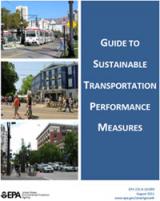Many transportation agencies are being called upon by their stakeholders to plan, build, and operate transportation systems that, in addition to achieving the important goals of mobility and safety, support a variety of environmental, economic, and social objectives. These include protecting natural resources, improving public health, strengthening energy security, expanding the economy, and providing mobility to disadvantaged people.
Guide to Sustainable Transportation Performance Measures (2011) is the outgrowth of a Smart Growth Implementation Assistance project assisting the California Department of Transportation. The report describes opportunities for transportation agencies to incorporate environmental, economic, and social sustainability into decision-making through the use of performance measures.
Performance measures allow decision-makers to quickly observe the effects of a proposed transportation plan or project or to monitor trends in transportation system performance over time. Local and regional transportation agencies are increasingly using sustainable transportation performance measurement to target their investments more effectively. This document provides examples of best practices being applied across the country.
This guidebook describes 12 performance measures that can readily be used in transportation decision-making, from transit accessibility to bicycle and pedestrian level of service. For each measure, the guidebook presents possible metrics, summarizes analytical methods and data sources, and illustrates its use by one or more transportation agencies.
Learn more about smart growth and transportation.
You will need Adobe Reader to view some of the files on this page. See EPA’s About PDF page to learn more.
